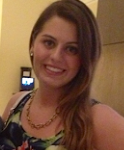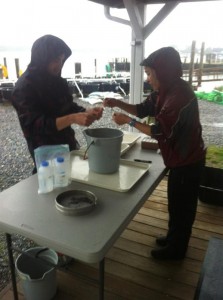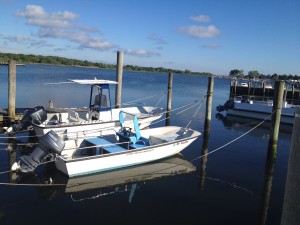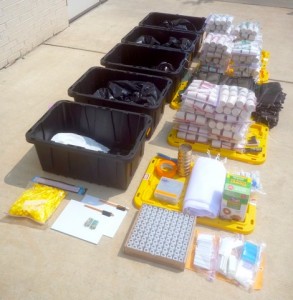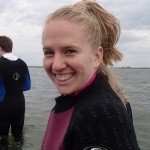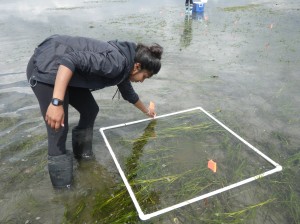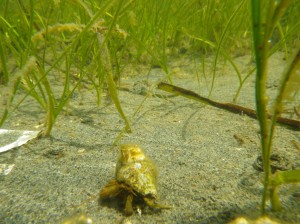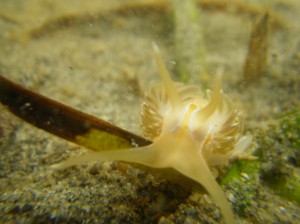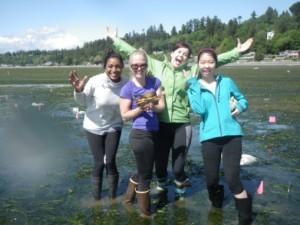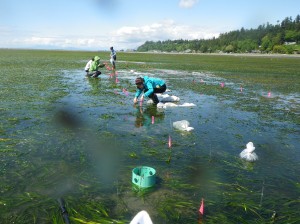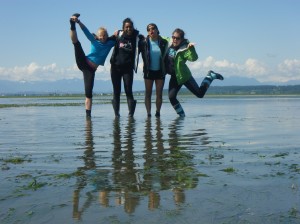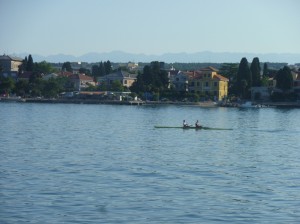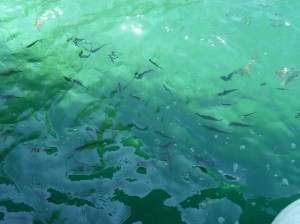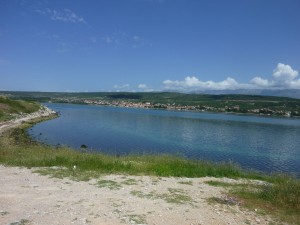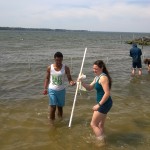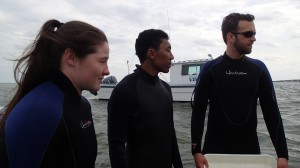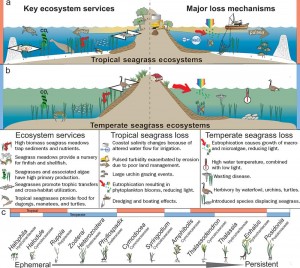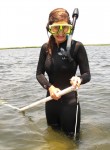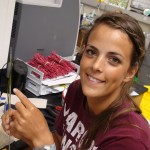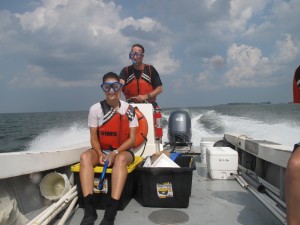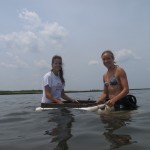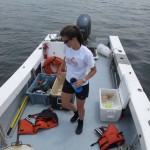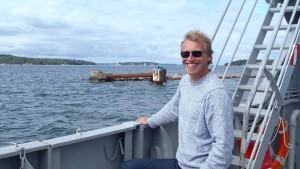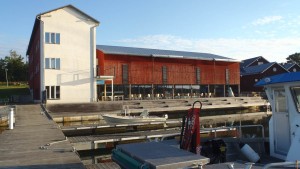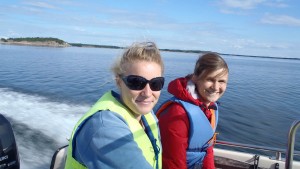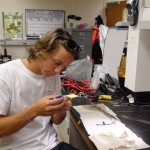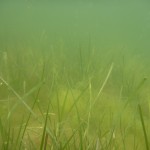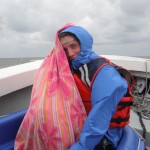A little closer to home – ZEN in Long Island Sound
by Ally Farnan (College of William and Mary undergraduate, ZENtern)
Even though Long Island is not a conventionally exotic location for a girl from New Jersey to spend the summer, it is starting out to be quite an adventure.
I arrived on site less than two weeks ago and I already feel like a part of the family here in the Peterson lab. I have spent the past week prepping for the ZEN experiments in the lab. Though a crucial step in the process of running experiments and conducting research, spending a week making aluminum packets, labeling, and weighing tins is not exactly thrilling. It is, however, a necessary part of the process, and is giving me some great practice for the eventual post-processing, sorting, and identification of field samples yet to come. I’m still figuring out where everything in the lab is located, but am getting some excellent help from the other undergraduate volunteers working the lab.
Luckily, I get to start running the actual experiments on Monday, which will also be the first time that I get to see the seagrass bed that we will be working in. Since I have been so busy in the lab, I haven’t had the opportunity to get into my wetsuit and see the site. The area that we are located in is beautiful, so I expect that the study site will also be wonderful!
I’m living a short drive from the lab with two graduate students, which gives me an interesting perspective on how different science research is from the typical 9-5 business job. My housemates, Rebecca and Sam, are excellent hosts and it’s so much fun to hear about the different kinds of research that they do. It should be really exciting to delve further into the experimental stages of ZEN so I can gain some hands-on experience myself.
The lab here is nearby, just off the water. The weather has been great most days, so I’ve been able to explore the area by jogging around town and by the beach. I hope to see some more of the sights around where I am staying. All of my new friends in the lab have given me some great ideas for how to spend my free time during the upcoming weekends - I can’t wait to discover what makes Long Island so special.
It is surprisingly chilly here, so I haven’t been brave enough to go swimming just yet since my toes freeze every time I stick them in the water. But, the sun is constantly shining, making for some beautiful drives around town with my windows down. I can’t wait to continue my adventures here by getting some fieldwork experience. I’ve already packed up my wetsuit so I don’t freeze in the cold water!
I’m so lucky to have a bunch of help in the lab, not only to settle me into a new space and help me to learn more about seagrass ecosystems, but also to advise me on some cold weather gear for our fieldwork in the next few weeks! I’m sure my future blog posts will be filled with some exciting fieldwork stories and hopefully I’ll still have a little free time to explore the area and tell you more about those experiences as well!
Thowback Thursday – Setting the Stage
Working with a large, global network of collaborators poses unique opportunities — as well as challenges. Before ZEN’s parallel experiments could start at the 15 widely scattered partner sites in 2011, the VIMS team had to purchase, fabricate, assemble, package, and ship the experimental materials to the sites located throughout the northern hemisphere. That summer we shipped out up to 6 crates and over 500 lbs of gear per site (that’s almost 3.8 tons total!). There was a lot to be done before we could pull on the dive booties and plunge into the water at our own site! For summer of 2014 the focus is on rigorous, controlled surveys and smaller scale experiments, which has the added benefit of less international shipping!
Tsawwassen – home to big isopods, eelgrass and crabs
by Danielle Hall (College of William & Mary undergraduate student, ZENtern)
After three days of intense lab preparation and field work, the first ZEN2 site has been completed!
I arrived in British Columbia late on May 15th and the next day we got straight to work. After prepping materials in the lab we hopped in the lab truck and headed to our field site in a town outside of Vancouver called Tsawwassen. This particular site is in an intertidal zone and we chose to work on the lowest tide of the year since, during any other time, the site would be submerged and difficult to access.
To get to the site we climbed down over two hundred steps. Next, in our fashionable rubber boots, we hiked our way through the mud to get to our site (a treacherous task since the mud had a habit of clinging to our boots). On more than one occasion help was required to extricate a sunken foot.
I was amazed at the size of the Zostera shoots. They were nearly twice the size of the eelgrass in my home field site in Virginia! Not only were the shoots large, but the isopods were comparatively gigantic as well.
I was joining on day two of the field work and so the 20 experimental plots were already marked with orange flags. On this day, our job was to deploy the predation assay. The purpose of this assay is to understand the relative predation rates across the different ZEN site. The experimental units, or ‘PTUs,’ consist of a piece of bait tethered to an acrylic rod. The baits ranged from local animals, like the giant isopods, to a standard control, a piece of cut dried squid. A PVC quadrat helped visualize where to place our PTUs.
Having spent several summers helping deploy previous ZEN projects in the Chesapeake Bay, I was very curious to discover the differences in eelgrass beds between the two coasts. Here, anemones abounded right on the eelgrass shoots. I was amazed that they were able to make a living on plant tissue since in all my past experiences I had only ever seen anemones attached to a hard substrate (There are anemones living in eelgrass beds in the Chesapeake Bay as well, but they are generally small and scarce.)
Our lab group got particularly excited about a pair of nudibranchs who then became the stars of a Hollywood-esque photoshoot. Meanwhile a bald eagle joined us for a bit, clearly finding a tasty meal within the seagrass.
Our second day in the field was filled with surprises. After recording the results of the predation assay (the bait was either gone – eaten, presumably – or present), we continued with collecting samples. After combing through the plots at least two times, Celine – another ZEN participant – uncovered quite a surprise: a huge Dungeness crab hiding in the mud! And he was not too happy that we were intruding in his home. One of the other women, Jemma, mustered up the guts to pick up the feisty crab, and we all gathered around to take a picture with our new friend.
Day two was a long afternoon of working in our plots. So long in fact that the tide decided to turn despite the fact that we still had half our plots to process. A race ensued. We were optimistic. The tide was persistent. We lost. I was in the process of taking sediment core samples when I noticed the tide line getting ever so close, though I was determined to finish. When I peeked over my shoulder, I decided I could finish three more plots. I didn’t even finish the one I was on. Soon water was rushing into our site.
I abandoned my own task to help others finish collecting algae. We developed an effective method of the two hand scoop, where we quickly ran both hands through the plot to work like a sieve. Soon the water engulfed our boots which was followed by multiple exclamations, but together we finished all the plots. Looking towards the shore, our samples and coolers were being carried by the tide. It took all our effort to traverse back to the shore, and on the way retrieve the heavy, runaway samples.
Danielle is a rising senior at the College of William and Mary. As a ZENtern she will be working with the lab of Dr. Mary O’Connor at the University of British Columbia in Vancouver, as well as back at the Virginia Institute of Marine Science with Dr. Emmett Duffy’s Marine Biodiversity Lab during summer 2014. She has been volunteering in Dr. Duffy’s lab for the past two years and is from Massachusetts. Aside from her passion for science, Danielle is an avid dancer.
The Adventure Begins
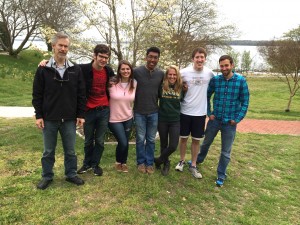
Dave Godschalk (second from the right) poses with Dr. Duffy (left) and the College of William & Mary ZEN class
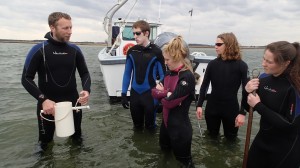
Dave (second from left) and ZEN classmates survey seagrass in the Chesapeake Bay before beginning their ZENternships
by David Godschalk (College of William & Mary undegraduate, ZENtern)
On my very first day of the ZEN Seagrass Ecology course at the College of William and Mary, I learned perhaps the most important lesson of the class, if not my scientific career. Our professor, Dr. Emmett Duffy, stood in front of our class and said these striking words:
“Things will not work out. You will mess up. Experiments will go wrong… Science is like that. The key, as an ecologist or any scientist for that matter, is to be able to adapt to those situations – to be creative and turn failures into successes. If you can do that, you will be successful not only as a scientist, but also as a person.”
As a geology major in an ecology class, this struck a chord with me. While I can go on and on about the structural and material properties that govern the Earth, different types of sandstones, and all those things near and dear to geologist’s hearts, I was out of my element in this course and I knew it. A fish out of water, one might say!
Those words on the first day are what saved me and I am so glad they did. Since then I have absolutely fallen in love with seagrass – the environment and the dynamics which govern the system. Even that particular seagrass-mud smell has grown on me. I will be writing entries for the ZEN Blog throughout the summer and one of my goals is to share with you my fascination with this unique environment. I hope to inspire you to feel the same way I do about this precious habitat and unprecedented project.
The Zostera Experimental Network (ZEN) is a collaborative, global study to examine what affects seagrass, and what role in turn seagrass play in coastal environments. What makes this project so unique is: (1) standardized experiments are performed worldwide, when often experiments in science can only be performed locally or regionally, and (2) undergraduate students (like me!) are sent to these global sites to practice and hone skills learned in class and contribute to the overall scientific study.
This summer I will be contributing to the ZEN research efforts in Zadar, Croatia, located across from Italy on the Adriatic Sea. It is a beautiful place and I am unbelievably excited to get things underway here. I will update you soon on how the experiments are going!
Dave is a graduating senior at the College of William & Mary and will be working with Dr. Claudia Kruschel in Croatia. His major is in geology with a marine science minor. Prior to studying seagrass ecology, Dave worked for Dr. Mark Patterson at the Virginia Institute of Marine Science on autonomous underwater vehicles (AUV) and completed an honors geology thesis. His favorite class at WM was structural geology – and rock climbing. When not snorkeling in the seagrass beds or surveying rocks he can be found running marathons.
Importance of knowing how to communicate science
by Jessie Viss (College of William & Mary undergraduate, ZENtern)
My bags are packed, my first hostel booked, and a pretty decent travel playlist has been downloaded to my iPod—I’m just about ready to head off to Portugal to work at the ZEN site there. Before this semester I didn’t even have a valid passport, and the farthest from home I’d ever been was when I left California to go to school in Virginia.
Needless to say I’m pretty excited about the prospect of spending two and a half months in Faro. The funny thing is, while I’ve always had a burning desire to see the world, that isn’t what’s got me practically giddy with excitement. No, what I’m most thrilled about is actually the work I’ll be doing this summer.
Throughout last semester we learned the methods for the different experiments that’ll be done across all the ZEN sites over the summer. While getting to go into the field made that class by far my favorite, the frigid waters made it so that the stars of the show were pretty scarce. But now we have the opportunity to really put into practice the procedures we’ve learned, to gather data that might test the theories of the papers we’ve read, to play a very small role in research that is of growing importance given the global trends indicating a decline in Zostera marina, so on the eve of my departure I think I’m within my bounds to geek out just a little.
My mom, on the other hand, is somewhat less enthused. Don’t get me wrong, she’s proud of me as only a mother can be, but is fairly uninterested in the scientific implications of the research. She’s been telling people I’ve landed an internship that has me spending my summer watching the grass grow. No attempts at explanation could convince her to phrase it any other way until one day the parents of a girl I went to elementary school with came into the restaurant where she works. They got to talking with her, and mentioned how their daughter also had a summer internship, working to preserve salmon populations in the delta that dominates the part of California we come from. Suddenly “watching grass grow” became an inadequate explanation, and when she got home mom asked just what exactly I’d be doing.
“Well there’s the podsicle experiment for one,” I began, “See, we take a small rod with a tether tied to it, glue some bait and put them out in the field for 24 hours.”
“Wait, what do you glue to these…popsicles…?”
“Podsicles, because we glue amphipods—little bug like things—to them to test relative predation rates,” I explained.
“And then what? Leave them out there in the water to get eaten?”
“Well—“
“So while Regina is out there saving the fishes you’re going to be gluing bugs to string??”
“Mom no, that’s not it. We’re testing how much predation there is at each site and perhaps the relative impacts of top-down processes—“
“I just can’t believe I raised a little mad scientist. Sure, now it’s just sea bugs, but how long until you’re in a white lab coat laughing maniacally and gluing people to rods.”
She was kidding, but has since gone back to telling people I’ll be watching grass grow. Seagrass, Mom. Maybe through my blog posts, and by the time I return from my ZENternship, I’ll be better able to show her the importance of the work I’m contributing to this summer.
Jessie is a rising junior at the College of William and Mary. She will be working with Dr. Aschwin Engelen in Portugal for her ZENternship this summer. Jessie is originally from California and this summer marks her first time traveling abroad.
Jessie was on the plane to Portugal while this post was undergoing final revisions, so, Jessie’s mom and parents of all of the ZENterns, this one’s for you:
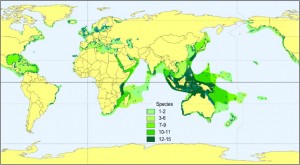
Seagrasses are diverse and found all over the world (image courtesy of Short et al. 2007: Global Seagrass Research Methods)
“Seagrass beds are an important, valuable, and widespread habitat that provide many important services to humanity. They contain many different species of plants and animals, including fishes and crabs that one day will end up our dinner plates. They help soak up the excess nutrients from fertilizers and waste that find their way into coastal waterways. Seagrasses also hold the soil together, which prevents erosion and lessens the impacts of coastal storms. They even help combat the effects of global climate change by capturing carbon, preventing it from accumulating in the atmosphere. As such, it’s vitally important that we understand what factors promote healthy seagrass beds.
The purpose of the Zostera Experiment Network is to, quite simply, understand how seagrass beds work. We will measure a suite of variables – some of them related to the environment, like temperature, salinity, and location, and some of them related to biology, like the number and diversity of animals found in the grass beds. We will relate these variables to inform our predictions about how seagrass beds function. By partnering with institutions all over the world, we can evaluate these predictions generally. ZEN represents an unprecedented effort to link process to function in a coastal habitat. Ultimately, the information obtained from ZEN will aid us in protecting and globally conserving this ecosystem, so it can continue to provide the services listed above.”
Kayaking in the Archipelago Sea
by Paul Richardson (VIMS technician)
The weather is beginning to warm here in Virginia, which means that soon I will be able to dust off my kayak and take it for a paddle in the nearby York River. The last time I went kayaking was over the summer when I was in in Finland. While there I was fortunate to have two wonderful and very hospitable neighbors in Korpoström, Heidi Arponen and Kevin O’Brien, who work for the Finnish Forestry Service known as Metsähallitus (Finnish), or Forststyrelsen (Swedish). In addition to taking me to lunch, having me for dinner and sharing many cups of tea, Heidi also invited me to go sea kayaking in the Baltic on her her SKUK Explorer. It was amazing. Heidi and Kevin mounted a GoPro camera on the front of my boat so that I can share the experience here. The GoPro took a still every 5 seconds. I hope you enjoy this virtual tour of the Baltic.
I’m a GRAZER baby…
by Pamela Reynolds (ZEN Coordinator)
As a small token of our appreciation for the hard work of all of the ZEN partners (past, present and future!), we present:
“GRAZER”. Turn up the volume and enjoy!
This film is, as everything in ZEN, a collaborative production and we very much appreciate the contributions of all of the ZEN participants. Lyrics were written by Paul Richardson, editing by undergraduate Conor MacDonnell, and lyrics by undergraduate Nick Penthorne. The film features cameos by Emmett Duffy and others in the Marine Biodiversity Lab at VIMS, as well as chorus refrains from many of the ZEN sites (watch the film all the way to the end so you don’t miss this!). The film premiered along with a select few other films on the big screen at the Beneath the Waves Film Festival at the Benthic Ecology Meeting last week in Savannah, GA. Enjoy!
Memorable moments in Virginia
by Katelyn Jenkins (College of William and Mary undergraduate student)
Many of the jobs I’ve tackled this summer have surprised me. I would not have guessed that I would become a PVC cutter, plaster block-maker, wire bender, mesh cutter, or sewer. However, I have learned that it takes a lot of skills, laughter, and water (often with a dash of Gatorade!) to prepare for such large-scale experiments in marine ecology. Through spending days of cutting many pieces of PVC and the messy job of making plaster blocks, I have enjoyed this job because of the new friends I have made in the MBL lab. From having numerous nicknames to help distinguish myself from the lab’s REU (also a Caitlin), to dancing on poles marking experimental cages in the field, this summer has been a great one to remember.
When I am not counting PVC or cutting wire, I have taken over the job of transferring seagrass samples from various ZEN partner sites to reinforced vials to grind down for nutrient (carbon and nitrogen) analysis. To do so, I have to go to William and Mary’s main campus to use a machine that will grind the samples (affectionately known as “Shakira” by its owner, Dr. Kerscher, who graciously allows us to use his lab space). The first few times I went to the main campus to grind the samples, the machine was placed in a lab. However, all of the large samples from partner sites makes for a very tired and warm ‘Shakira’. To resolve this, I planned to take breaks between sample grinding during my next visit. But, when I arrived on campus weeks later in almost 100° F weather in my shorts and t-shirt, I had no idea the machine was being moved to a cold room of 34° F! Though the initial “air conditioning” felt much needed, I quickly found myself freezing (literally) while trying to grind my samples. With multiple “defrost-Katelyn” steps inserted into the protocol (which involved running outside into the muggy Virginia heat until my fingers had thawed), I was able to successfully grind all of the samples. I can now say that I always come prepared with full gear to face the cold room. You can easily spot me walking across campus as I am the only one with a big jacket and pants in the middle of summer!
Aside from the strange climactic working conditions, I spend a lot of time in the field – one of my favorite parts! I have learned to master “Snorkeleese”, the language when talking with a snorkel in your mouth and your face down in the seagrass bed. “Ooo uoooo eeeddd elpppp?” translates easily to “Do you need help?” and “ablee eye eeese” almost always means “cable tie please”. All joking aside, most importantly I have had the chance to snorkel in the Goodwin Islands and see tons of marine life, all while learning the ins and outs of getting experiments set-up and broken-down in the field.
After taking a Marine Ecology course at William and Mary, it has been very exciting to see a lot of the things that I have read many papers on. For example, I read many papers on seagrass beds and algal blooms in the Bay and it is very interesting to see these different topics hands-on. One of the most interesting experiences I have had with marine life during the ZEN project was during the break down phase. While riding from our field site back to VIMS, about 15 dolphins began to swim around us as they searched for food. It was very exciting to see these animals so closely, especially because I have never seen so many in the York River before! Aside from this, I have had the opportunity to see tons of crabs, fish, and even sting rays!
Overall, this summer has been an incredible experience that has taught me many valuable skills. I can’t wait to see what lies ahead!
Dispatches from Finland: Arrival
by Paul Richardson (VIMS Marine Biodiversity Lab technician)
The Long Journey from Virginia to Turku and then Korpoström
At over 6500km, traveling to Finland was the longest journey I’ve ever made. At 42 years of age I’ve never been out of North America, and traveled only once outside of the United States (a brief ski trip to Canada a few years back). With all of the ZEN research going on at VIMS right up until my departure, I had little time to be nervous for my first true international travel experience. My United flight on a spanking new 757 provided surprisingly good food, and there was a selection of movies. One thing, however, that I really appreciated was the flight monitor where I could see the plane’s progress, its speed, the arrival time (which was always further away than I wanted!), the temperature outside of the plane, etc. Being the irrationally nervous flyer that I am, it was somewhat comforting to know that the altitude was 36000 feet, speed was 580mph, and the temperature outside was -60oF. Sitting upright and cramped, combined with my excitement for the trip, I couldn’t sleep a wink all night.
In Copenhagen I was thrilled to get my first passport stamp. Then I boarded a bus to go across the tarmac to a Scandinavian Airlines flight to Turku, Finland! The plane was pretty empty – the benefit of flying into Turku at the end of the tourist season. Every other seat was vacant, which would have been nice for the trans-Atlantic flight.
During our approach, we flew right over the Archipelago Sea where we are conducting the ZEN experiments in Finland. I snapped a few pictures of some of the estimated 30,000 islands. Despite the cloud cover obscuring some of the smaller islands, it was comforting that the view looked like a more vibrant version of the Google Earth images that I viewed a few days prior.
Stocking Up with Provisions!
Once on the ground in Turku, I was thrilled to find that all of my bags made it through four connections and two airlines half way across the world. I was even more thrilled to find that ZEN collaborator, Dr. Christoffer Boström, was waiting for me just outside the gate. First we went to the City Market in Turku to stock up on food and other supplies before traveling to the marine station on the island of Korpoström . The City Market is amazing. It’s the size of a Super Wal-Mart back home, with a department store and a grocery store, but most of the food and produce is local and luomu (organic). I had no idea what any of the labels said, but Christoffer, a self-proclaimed food nerd, gave me the tour. When he said something was good, more often than not, it went into my cart.
With my blond hair and standing 6 feet tall, I didn’t feel terribly like I stuck out as a tourist until I asked for a grocery bag. Most of the stores in Finland (and I’m told Europe in general) do not give out grocery bags. If you don’t bring one, you have to buy one. City Market generously gave me one – my first welcome to Finland present! The bags are big so I managed to get all of my 100+ Euros worth of food into it. I got many delicious meats, breads, herrings (I love pickled herrings!) and luomu produce – tasty, but food here is not cheap! Cans and bottles have 15 cents tacked onto the price of each so that you can bring them back for 15 cent refunds each. Didn’t we used to do that back in the States?
A Little More on the Subject of Food
The summer in Finland is an amazing time to visit if you’re a food nerd (or foodie, as we say). Because the sun shines for so long during the day, and at a low angle, the produce is extremely flavorful. Carrots and potatoes and other veggies are about half the size of what I’m used to in the U.S., but they are twice as flavorful. You can also go into the woods and pick berries. You’re even allowed to go onto private property as long as you stay at least 300 meters from any dwelling. With long days of fieldwork and lab processing I haven’t exactly had time to go berry picking in the woods, but I have picked a few on the side of the road and I’ve bought more than a few. If you do plan to go berry picking in Finland though, you need to beware of ticks and getting lost. Apparently, more than one berry picker has fallen victim to ticks and their associated diseases or wandered away and never made it home. The good thing about being on a small island like Korpoström where the marine station is located, is that if you do get lost you can always walk until you find the coast and then follow it home.
My New Digs
After the trip to the market, Christoffer and I took a two hour scenic drive and two ferry rides to my new home for the rest of the summer in Korpoström.
Åbo Akademi University’s field station is in Korpoström which is an island in the Archipelago Sea. This facility is a unique melding of modern art, science, and recreation. On one side you have the Strandboden (beach hut) that is basically a hotel with a marina. Then on this side there are the Åbo Akademi labs, offices and my quarters (a modified office). The park service also has some space and there’s a restaurant and a museum. All of this is situated conveniently on the water where our research vessels are located. I’ve been to the restaurant three times and it is delicious, but mostly I cook my own food purchased from the market trip in the little kitchen upstairs. Listening to all the numerous non-English conversations going on at the Strandboden and the restaurant, I still feel like a tourist, very far from home. But, I am slowly becoming accustomed to my new surroundings, and I can definitely spot the tourists. They speak English.
The Finland 2012 Crew
In addition to Christoffer and myself, there are three very skilled graduate students helping out with the ZEN work: Marie Järnström, Camilla Gustafsson, and Anna Törnroos. Anna was here for one week for the set up and to be Camilla’s dive buddy. Camilla is a PhD candidate at Åbo Akademi University who will be defending soon. Marie is Christoffer’s intern and a master’s student of Åbo Akademi; she will leave to continue her studies at the end of August. These gals are all pretty much locals. Among other languages, they all speak Swedish and, luckily for me, they all speak English very fluently. I’m not sure exactly where Cami and Anna are from, but Marie is from the island of Mossaia, which is three ferries to the North West.
That’s it for now – I’ll save descriptions of the field site and the natural history of the Archipelago for my next dispatch.
The business of science
by John Schengber (VIMS undergraduate student summer intern)
I am an undergraduate at James Madison University and have been working this summer with the ZEN team at the Virginia Institute of Marine Science in Gloucester, Virginia. I have lived right across the river in neighboring Yorktown for most of my life. Surrounded by nature and adventure, I have become an outdoor kind of guy with an intense curiosity and respect for nature. I still have not decided the exact career path I want to take, so this summer was an excellent opportunity to explore research and marine biology.
I think most people in the lab were surprised when I revealed that I am in fact a business major. Everyone else around here studies (go figure) science. In the fall, I will be returning for my sophomore year at James Madison University, where I am pursuing a major in International Business coupled with a double minor in Spanish and Environmental Science. Now, why in the world would a business major be working in a science lab? First, let me emphasize that this career direction is not entirely definitive for me. I am fascinated by a myriad of fields of study. In business, I am drawn to the ideas of entrepreneurship and creativity, but not so much to the possibility of cubicle entrapment. I dream of running my own company, but am conflicted as business/industry can often be a driving force in the destruction of our natural world.
My love for science stems from my love for nature and the questions it begs us to answer. I am in constant awe of its wonder, and my life would be at loss if my studies lacked a good dosage of the biological sciences. Yet I love to interact with people (especially in Spanish), to solve problems, and to try new ideas in the business sector. So, I have come to a crucial intersection of interests. Business seems to be the last thing to enter if one is focused on saving the world from its own ruin. But I wonder if it can be done differently? Can we make a business that is not just sustainable but truly symbiotic with our environment? Most importantly, can this venture be profitable in a cut-throat capitalist economy? Lastly, can I be the person to do this? I have no idea. But I’d say it’s worth a shot.
So here I am at the Virginia Institute of Marine Science taking that first step. I came into this position with a few hopes and expectations. I wanted to check out the work of a marine biologist, which is my greatest love in science and the field that I would most likely enter if I decided to pursue a research career. I hoped that I would meet some incredible people with inspiring intelligence and personalities to match. I wanted to view the process of scientific investigation from beyond classroom instruction or media coverage. I wanted to learn a lot and experience even more. But really I just wanted to hang out with some amphipods.
All of my hopes and expectations have been fulfilled, and I have loved every minute of it. I have made new friends and linked up with old ones (see Nicole Rento’s post, fellow lab member this summer and best friend since, well, forever). I have learned more than I could have ever imagined. I have spent some quality time with lots and lots of amphipods. And I’ve learned that running a lab really isn’t too much different than running a business. There are budgets, deadlines, management, and lots and lots of ingenuity. Maybe there’s hope for me yet.

